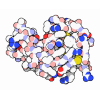+ Open data
Open data
- Basic information
Basic information
| Entry | Database: PDB / ID: 1l0k | ||||||
|---|---|---|---|---|---|---|---|
| Title | METHIONINE CORE MUTANT OF T4 LYSOZYME | ||||||
 Components Components | LYSOZYME | ||||||
 Keywords Keywords | HYDROLASE / hydrolase (o-glycosyl) / T4 lysozyme / methionine core mutant / protein engineering / protein folding | ||||||
| Function / homology |  Function and homology information Function and homology informationviral release from host cell by cytolysis / peptidoglycan catabolic process / cell wall macromolecule catabolic process / lysozyme / lysozyme activity / host cell cytoplasm / defense response to bacterium Similarity search - Function | ||||||
| Biological species |  Enterobacteria phage T4 (virus) Enterobacteria phage T4 (virus) | ||||||
| Method |  X-RAY DIFFRACTION / X-RAY DIFFRACTION /  MOLECULAR REPLACEMENT / Resolution: 2.02 Å MOLECULAR REPLACEMENT / Resolution: 2.02 Å | ||||||
 Authors Authors | Gassner, N.C. / Baase, W.A. / Mooers, B.H. / Busam, R.D. / Weaver, L.H. / Lindstrom, J.D. / Quillin, M.L. / Matthews, B.W. | ||||||
 Citation Citation |  Journal: BIOPHYS.CHEM. / Year: 2003 Journal: BIOPHYS.CHEM. / Year: 2003Title: Multiple methionine substitutions are tolerated in T4 lysozyme and have coupled effects on folding and stability Authors: Gassner, N.C. / Baase, W.A. / Mooers, B.H. / Busam, R.D. / Weaver, L.H. / Lindstrom, J.D. / Quillin, M.L. / Matthews, B.W. #1:  Journal: Biochemistry / Year: 1999 Journal: Biochemistry / Year: 1999Title: Methionine and alanine substitutions show that the formation of wild-type-like structure in the carboxy-terminal domain of T4 lysozyme is a rate-limiting step in folding Authors: Gassner, N.C. / Baase, W.A. / Lindstrom, J. / Lu, J. / Dahlquist, F.W. / Matthews, B.W. #2:  Journal: Biochemistry / Year: 1987 Journal: Biochemistry / Year: 1987Title: Structure of bacteriophage T4 lysozyme refined at 1.7 A resolution Authors: Weaver, L.H. / Matthews, B.W. | ||||||
| History |
|
- Structure visualization
Structure visualization
| Structure viewer | Molecule:  Molmil Molmil Jmol/JSmol Jmol/JSmol |
|---|
- Downloads & links
Downloads & links
- Download
Download
| PDBx/mmCIF format |  1l0k.cif.gz 1l0k.cif.gz | 47.5 KB | Display |  PDBx/mmCIF format PDBx/mmCIF format |
|---|---|---|---|---|
| PDB format |  pdb1l0k.ent.gz pdb1l0k.ent.gz | 33.6 KB | Display |  PDB format PDB format |
| PDBx/mmJSON format |  1l0k.json.gz 1l0k.json.gz | Tree view |  PDBx/mmJSON format PDBx/mmJSON format | |
| Others |  Other downloads Other downloads |
-Validation report
| Arichive directory |  https://data.pdbj.org/pub/pdb/validation_reports/l0/1l0k https://data.pdbj.org/pub/pdb/validation_reports/l0/1l0k ftp://data.pdbj.org/pub/pdb/validation_reports/l0/1l0k ftp://data.pdbj.org/pub/pdb/validation_reports/l0/1l0k | HTTPS FTP |
|---|
-Related structure data
| Related structure data | 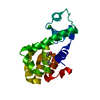 1ks3C 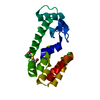 1kw5C 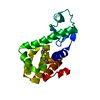 1kw7C 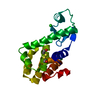 1ky0C 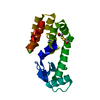 1ky1C 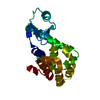 1l0jC  1lpyC 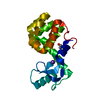 1lw9C 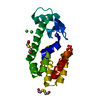 1lwgC 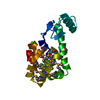 1lwkC C: citing same article ( |
|---|---|
| Similar structure data |
- Links
Links
- Assembly
Assembly
| Deposited unit | 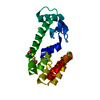
| ||||||||
|---|---|---|---|---|---|---|---|---|---|
| 1 |
| ||||||||
| Unit cell |
|
- Components
Components
| #1: Protein | Mass: 18541.395 Da / Num. of mol.: 1 / Mutation: C54T,L84M,L91M,C97A,L99M,V111M,L118M,L121M,L133M Source method: isolated from a genetically manipulated source Source: (gene. exp.)  Enterobacteria phage T4 (virus) / Genus: T4-like viruses / Species: Enterobacteria phage T4 sensu lato / Gene: gene E / Plasmid: phs1403 / Production host: Enterobacteria phage T4 (virus) / Genus: T4-like viruses / Species: Enterobacteria phage T4 sensu lato / Gene: gene E / Plasmid: phs1403 / Production host:  | ||||
|---|---|---|---|---|---|
| #2: Chemical | | #3: Chemical | ChemComp-HED / | #4: Water | ChemComp-HOH / | |
-Experimental details
-Experiment
| Experiment | Method:  X-RAY DIFFRACTION / Number of used crystals: 1 X-RAY DIFFRACTION / Number of used crystals: 1 |
|---|
- Sample preparation
Sample preparation
| Crystal | Density Matthews: 2.82 Å3/Da / Density % sol: 56.42 % |
|---|---|
| Crystal grow | Temperature: 277 K / Method: vapor diffusion, hanging drop / pH: 6.9 Details: Na2PO4, NaCl, pH 6.9, VAPOR DIFFUSION, HANGING DROP, temperature 277K |
-Data collection
| Diffraction | Mean temperature: 298 K |
|---|---|
| Diffraction source | Source:  ROTATING ANODE / Type: RIGAKU RU200 / Wavelength: 1.5418 Å ROTATING ANODE / Type: RIGAKU RU200 / Wavelength: 1.5418 Å |
| Detector | Detector: AREA DETECTOR |
| Radiation | Monochromator: graphite / Protocol: SINGLE WAVELENGTH / Monochromatic (M) / Laue (L): M / Scattering type: x-ray |
| Radiation wavelength | Wavelength: 1.5418 Å / Relative weight: 1 |
| Reflection | Resolution: 2.02→30 Å / Num. all: 14356 / Num. obs: 14356 / % possible obs: 90.4 % / Redundancy: 2.8 % / Biso Wilson estimate: 28.9 Å2 / Rmerge(I) obs: 0.055 / Net I/σ(I): 9.6 |
| Reflection shell | Resolution: 1.78→1.86 Å / Redundancy: 1.8 % / Rmerge(I) obs: 0.267 / Num. unique all: 2587 / % possible all: 63.5 |
- Processing
Processing
| Software |
| ||||||||||||||
|---|---|---|---|---|---|---|---|---|---|---|---|---|---|---|---|
| Refinement | Method to determine structure:  MOLECULAR REPLACEMENT / Resolution: 2.02→30 Å / Stereochemistry target values: TNT PROTGEO / MOLECULAR REPLACEMENT / Resolution: 2.02→30 Å / Stereochemistry target values: TNT PROTGEO /
| ||||||||||||||
| Refinement step | Cycle: LAST / Resolution: 2.02→30 Å
|
 Movie
Movie Controller
Controller



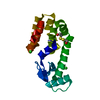
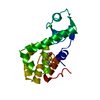
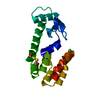
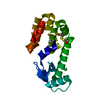
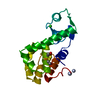
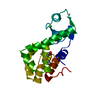
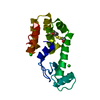

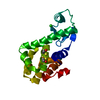

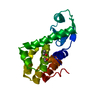
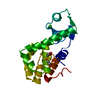
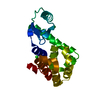
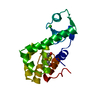

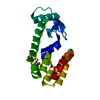

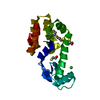

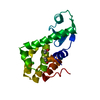
 PDBj
PDBj